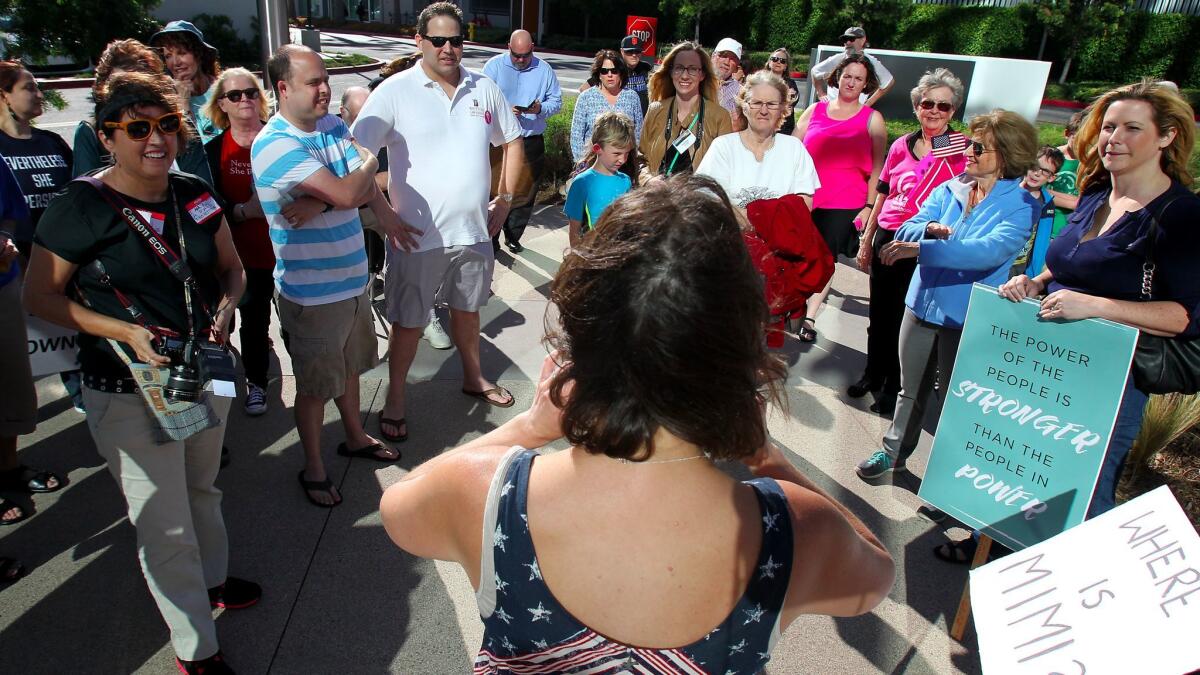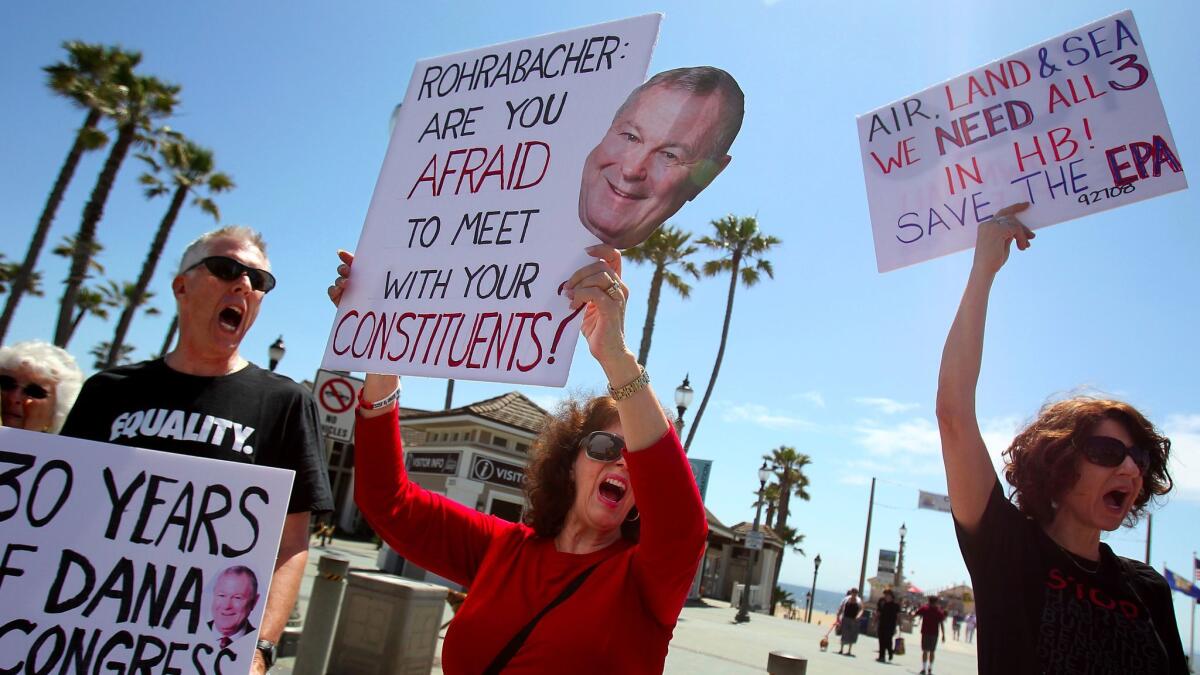Jolted by Trump, Orange County Democrats see a shot at victory on GOP turf

- Share via
Catherine Nadeau was never a supporter of Rep. Dana Rohrabacher, but as a resident of historically conservative Orange County she had never bothered to get involved in local politics either.
Donald Trump’s surprise presidential win changed that.
“This has been a wake-up call for me that it’s very important, that you need to vote locally,” Nadeau, 48, said as she and two dozen district residents waved signs about climate change outside Rohrabacher’s office on a recent sunny Tuesday. “I can’t do anything about getting Trump out right now, but I can do something in the next 567 days to get this guy out.”
Nadeau is among the newly energized residents giving Democrats hope they can claim at least some of the congressional seats in Orange County that have been red for a generation. Despite the vocal optimism from activists and local dissatisfaction with Trump, it will be an uphill battle for Democrats to flip the four heavily Republican congressional districts in Orange County, all but one of which the incumbent won in 2016 by double digits.
More than a dozen resistance groups have formed in Orange County since the presidential election. They’ve demanded meetings with the four Republican members of Congress, and staged town halls in their name when the members decline. They’ve delivered petitions and Valentines and even protested outside the members’ homes. Most Tuesdays, at least a few dozen people show up with signs outside district offices (some of which they’ve been told they can no longer enter).
They’re bolstered by the fact that last fall marked the first time Orange County chose a Democrat for president since 1936, a gradual decline in voters registering as Republicans and growing numbers of Latino and Asian voters.
Ground zero
So, 17 months before the 2018 election, the Democratic Congressional Campaign Committee is making Irvine ground zero for its efforts in western states, with a full-time staff member brought in to help with races.
The four targeted Republicans are Reps. Ed Royce of Fullerton, Mimi Walters of Irvine, Dana Rohrabacher of Huntington Beach and Darrell Issa of Vista. They have been among the most lambasted after Republicans voted to roll back the Affordable Care Act.
Though the minority party historically wins seats in midterm elections, the national Democratic Party faces a tough path to flip the 25 districts it needs to reclaim majority control of the House in 2018.
Fewer and fewer congressional districts are considered competitive, so districts where the political parties think they have a chance — such as places where voters picked a member of Congress from one party and a president from another — can expect to see a lot of action in the coming months. (Radio and online attack ads are already running in Orange County.)
Seven of the 23 congressional districts that sent a Republican to the House and also picked Hillary Clinton for president are in California.
“They need to cast a wide net for opportunities, and as soon as Donald Trump lost Orange County that set off some sirens at the DCCC,” said Nathan Gonzales, editor of the nonpartisan political analysis site Inside Elections.
But that doesn’t mean voters there are suddenly Democrats
Perhaps Republicans just didn’t like Trump, Gonzales said. That doesn't make them liberals.
“I just don’t know that we can throw away a couple of generations of history, of election results, after one race,” he said.
Except for president, Republicans won the majority of other races in Orange County, all the way down the ticket. The state’s voters rejected a ballot measure to require voter approval of revenue bonds, but the county voted 57.1% in favor. A vote signaling opposition to the Citizens United decision allowing money to flood into politics passed statewide but garnered just 46.6% in Orange County.
Republicans still lead voter registration here, though they make up less than 45% of registered voters in any of the targeted congressional districts.
Democrats have managed to narrow the registration gap over the last four years from 10 percentage points to 3.7 points, and they'll have to continue to chip away if they want to win seats. Almost a third of voters are registered as having no party preference, and Democrats are hoping to leverage independent voters to win. As one activist pointed out, the majority of voters in Orange County don’t back the Republican Party, and might be willing to go in a new direction.
The normal political rules don’t seem to apply right now
Orange County Democratic Party Chairwoman Fran Sdao said she has never experienced anything like this enthusiasm. The number of local Democratic clubs has nearly doubled since the election, and her phone rings off the hook with people asking what they can do to help.
“I don't think any of us could have predicted this surge in interest," she said. “We’re kind of in uncharted territory."
That’s already attracted four Democrats challenging Rohrabacher, three in Walters’ district, two for Issa and one for Royce. Sdao said about a dozen more people have expressed interest in running.
Which candidate has the best chance to grab a Republican seat? Narrowing the field may be the most delicate part of Democrats’ balancing act. The national Democratic Party has a history in California of backing candidates who can raise a lot of money but don’t always have strong local ties.
The first hints of that habit are popping up in Walters’ 45th District, where the national party appears more excited about UC Irvine associate law professor Dave Min over UC Irvine law professor Katie Porter, who has been active with the local resistance groups. Both Democrats have started making appearances at the protests outside of Walters’ office.
After this story was published, a spokesman for the DCCC said the party supports all the Democrats in the race. And at the local level, Sdao said Democrats aren’t picking favorites just yet. “They just need to go out there and talk to people,” Sdao said. “We’re just going to hope they weed themselves out a little bit.”
Picking battles
Democratic strategist Mike Trujillo said Democrats have a better chance of flipping seats in the Central Valley, where they’ve trained operatives and built a political infrastructure over years of challenging the region’s Republicans. In 2016, voters reelected Reps. David Valadao (R-Hanford) and Jeff Denham (R-Turlock) but also backed Clinton for president.
“I don’t believe you have that same cohort of field organizers that have been trained in Mimi Walters’ district, or Dana Rohrabacher’s district,” Trujillo said. “When you have the infrastructure in place like we do in the Central Valley it just gives you the edge and it makes the chances of flipping those districts even better.”
Democrats have to set their sights on more seats than they expect to win, and that probably includes some of the long-shot Orange County seats, he said.
“You sort of have to over-target if we really want to flip the House. You can’t just go after the 25 seats that we need,” he said.

A heavy lift
Flipping seats held by the other party for generations with 17 months of investment isn’t a light lift, said California Republican strategist Jason Cabel Roe.
In his Irvine law office, Orange County Republican Party Chairman Fred Whitaker seemed pleased by the idea of Democrats aiming to win local races.
“Let them spend their money,” Whitaker said with a laugh. “If they are spending all their money here where we’re going to win, then that allows us to win in other places where Democrats might have a chance across the nation.”
He noted that Rohrabacher won reelection in 2016 by 16.6%, Royce by 14.4% and Walters by 17.2%. Even in the closest race, where Issa eked out a win over a novice opponent with 0.6%, or 1,621 votes, the congressman performed strongly in the Orange County section of the district.
Whitaker also dismissed the activists as the same group of people moving from district office to district office.
“Orange County doesn’t respond real well to mass protests,” Whitaker said. “It does nothing but help us.”
California 45th organizer Amy Stevens smiled at Whitaker’s take.
“That’s OK. I would love for them to continue to think that way, because that will mean that they won’t fight hard enough and it gives us an even better chance,” the 43-year-old from Mission Viejo said.
Stevens joined two dozen people to march from Walters’ Irvine office to a nearby intersection to wave signs. At protests throughout the county, people told the same story: They didn’t realize how many of their neighbors were frustrated with Republicans until after the election and the women’s marches that took many by surprise the day after the inauguration.
Stevens, a lifelong Democrat, said she respected Walters’ experience as a local volunteer and even voted for the Republican in her first race.
“We were all really complacent before this election, thinking that we lived in safety and things weren’t that bad in Orange County,” Stevens said. “People who lived here just sort of assumed it was red and the Democratic Party assumed it was red too. I don’t think there was very much effort made to make any change.”
Follow @sarahdwire on Twitter
Read more about the 55 members of California's delegation at latimes.com/politics
ALSO:
California's Republicans all voted yes on the healthcare bill. Now Democrats have a campaign issue
Will California's surge of liberal activism pull legislators to the left?
Updates on California politics
UPDATES:
9:45 a.m.: This article was updated with a comment from the DCCC on the 45th District candidates.
This article was originally published at 12:05 a.m.
Get the L.A. Times Politics newsletter
Deeply reported insights into legislation, politics and policy from Sacramento, Washington and beyond. In your inbox three times per week.
You may occasionally receive promotional content from the Los Angeles Times.








